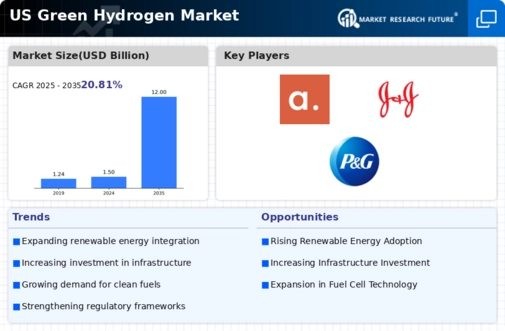Corporate Sustainability Initiatives
Many corporations in the US are increasingly adopting sustainability initiatives, which are driving the growth of the green hydrogen market. Companies are setting ambitious targets to achieve net-zero emissions by 2050, prompting investments in renewable energy sources, including green hydrogen. For instance, major players in the automotive and manufacturing sectors are exploring hydrogen fuel cells as a viable alternative to traditional energy sources. This trend is reflected in the fact that over 50% of Fortune 500 companies have committed to sustainability goals, which often include the integration of green hydrogen into their energy strategies. As corporate responsibility becomes a priority, the green hydrogen market is likely to see substantial growth fueled by these initiatives.
Advancements in Electrolysis Technology
Recent advancements in electrolysis technology are significantly enhancing the efficiency and cost-effectiveness of green hydrogen production. Innovations in proton exchange membrane (PEM) and alkaline electrolysis are making it feasible to produce hydrogen at lower costs, potentially under $2 per kg by 2030. This reduction in production costs is crucial for the green hydrogen market, as it allows for competitive pricing against fossil fuels. Furthermore, the integration of renewable energy sources, such as wind and solar, with electrolysis systems is expected to increase the overall efficiency of hydrogen production. As these technologies continue to evolve, they are likely to drive the growth of the green hydrogen market, making it a more attractive option for energy producers and consumers alike.
Rising Demand for Clean Energy Solutions
The green hydrogen market is experiencing a notable surge in demand as industries and consumers increasingly prioritize clean energy solutions. This shift is driven by a growing awareness of climate change and the need to reduce greenhouse gas emissions. In the US, the energy sector is projected to invest over $100 billion in renewable energy technologies by 2030, with green hydrogen playing a pivotal role in this transition. The market is expected to grow at a CAGR of approximately 15% through the next decade, indicating a robust appetite for sustainable energy sources. As companies seek to decarbonize their operations, the green hydrogen market is likely to benefit from this trend, positioning itself as a key player in the future energy landscape.
Government Policy and Funding Initiatives
Government policy and funding initiatives are playing a crucial role in shaping the green hydrogen market. The US government has introduced various programs aimed at promoting clean energy technologies, including green hydrogen. For example, the Department of Energy has allocated over $8 billion for hydrogen research and development through the Hydrogen Energy Earthshot initiative. This funding is expected to accelerate innovation and deployment of hydrogen technologies across various sectors. Additionally, state-level policies are increasingly supportive of hydrogen projects, with several states offering incentives for green hydrogen production and utilization. These government actions are likely to create a favorable environment for the growth of the green hydrogen market, attracting investments and fostering collaboration among stakeholders.
Growing Interest in Hydrogen as an Energy Carrier
The growing interest in hydrogen as an energy carrier is significantly impacting the green hydrogen market. Hydrogen's versatility allows it to be utilized in various applications, including transportation, industrial processes, and energy storage. As the US transitions towards a more sustainable energy system, hydrogen is being recognized for its potential to store excess renewable energy and provide a reliable energy source. The market for hydrogen fuel cells in transportation is projected to reach $20 billion by 2030, indicating a strong demand for hydrogen-powered vehicles. This increasing recognition of hydrogen's role in the energy transition is likely to bolster the green hydrogen market, as stakeholders seek to capitalize on its potential benefits.














Leave a Comment